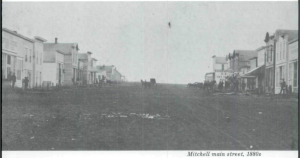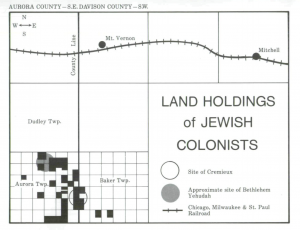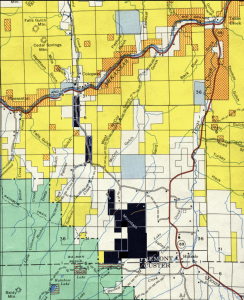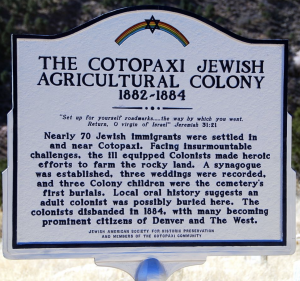After decades of failed Jewish farming experiments in the mid-nineteenth century, our story continues in 1881. In that year, small groups of young Jews in the Russian Empire formed a radical movement called Am Olam (or Am Oylam in Yiddish, meaning “Eternal people”). These groups came together in response to murderous anti-Jewish pogroms sweeping Ukraine following the assassination of Tsar Alexander II. Members of Am Olam believed that emigration to the United States would allow them to escape repression and create utopian agricultural colonies.
Funded by local Jewish communities, from 1881 to 1886, Am Olam settled and then abandoned more than twenty communes in far-flung locations around the United States. A total of several hundred idealistic Am Olam members emigrated from the Russian Empire. Some of these groups dissolved en route from Europe to New York or shortly after their arrival there.

Group photo of the New Odessa Community
Credit: The New York Public Library Digital Collections
Those who remained did establish farming communes in far-flung locations in Louisiana, the Great Plains and elsewhere in the American hinterland. Am Olam arrived in Canada, settling approximately 30 families in the Moosomin and Hirsch colonies near Winnipeg in 1884 and 1892.
The first Am Olam commune, founded on Sicily Island in late 1881, in Catahoula Parish, Louisiana, was led by a man (Herman Rosenthal, 1843-1917) destined for important public roles, included 151 pioneers. Funded by a $2,800 grant from the Alliance Israèlite Universelle in Paris and additional support from philanthropists in New Orleans, this commune seemed doomed from the start despite the enthusiasm of the Am Olamniks. Lack of farming experience, intense summer heat, distance from major cities, ideological rigidity, flooding from the Mississippi River and disease defeated all their effort within two years. Some returned to New York, some moved to a Am Olam commune in South Dakota (Crémieux), while a handful of others purchased private farms in Kansas and Missouri. Like Sicily Island, Crémieux failed within three years.
Click on the images below to view them in greater detail
Credit: The South Dakota Historical Society
Click the link below to view the full article from which these images are taken:
Rural Oregon was home to the third Am Olam commune, New Odessa, 250 miles southwest of Portland. With money donated mostly by a prominent Jewish leader, Jacob Schiff of New York, in the summer of 1882 the New Odessa commune was settled by Am Olam. After emigrating from Odessa (Ukraine) to New York, they travelled to their new communal home. The funders purchased about 760 acres, much of which was forest meant for sale as lumber to local railroads and then cleared for planting. The first 23 communards arrived in the summer of 1882, with an intent to gradually add communards. At its height, New Odessa was home to approximately 65 settlers. From multiple accounts, its first two years saw considerable progress, with construction of several buildings. But like Sicily Island, New Odessa’s rigid collectivist and atheistic lifestyle eventually led to frictions. It was not long before the more earthly challenges of drought, fire and distance to potential markets for agricultural produce doomed New Odessa by 1886. Some members then formed an urban commune in San Francisco.
To learn more about the New Odessa commune, read the essay in the
Am Olam also established short-lived communes in Michigan and in Colorado among other far flung locations in North America. For information on the Bad Axe Michigan commune, click here.
Images from the commune in Cotopaxi Colorado can be seen below. Further information on the history of Cotopaxi can be found here.
Click on the images below to view them in greater detail
The area of Cotopaxi commune is marked in black on the map.
Except for Alliance and Carmel, both in southern New Jersey, all of the Am Olam communes in the United States dispersed by the mid-1890s.




